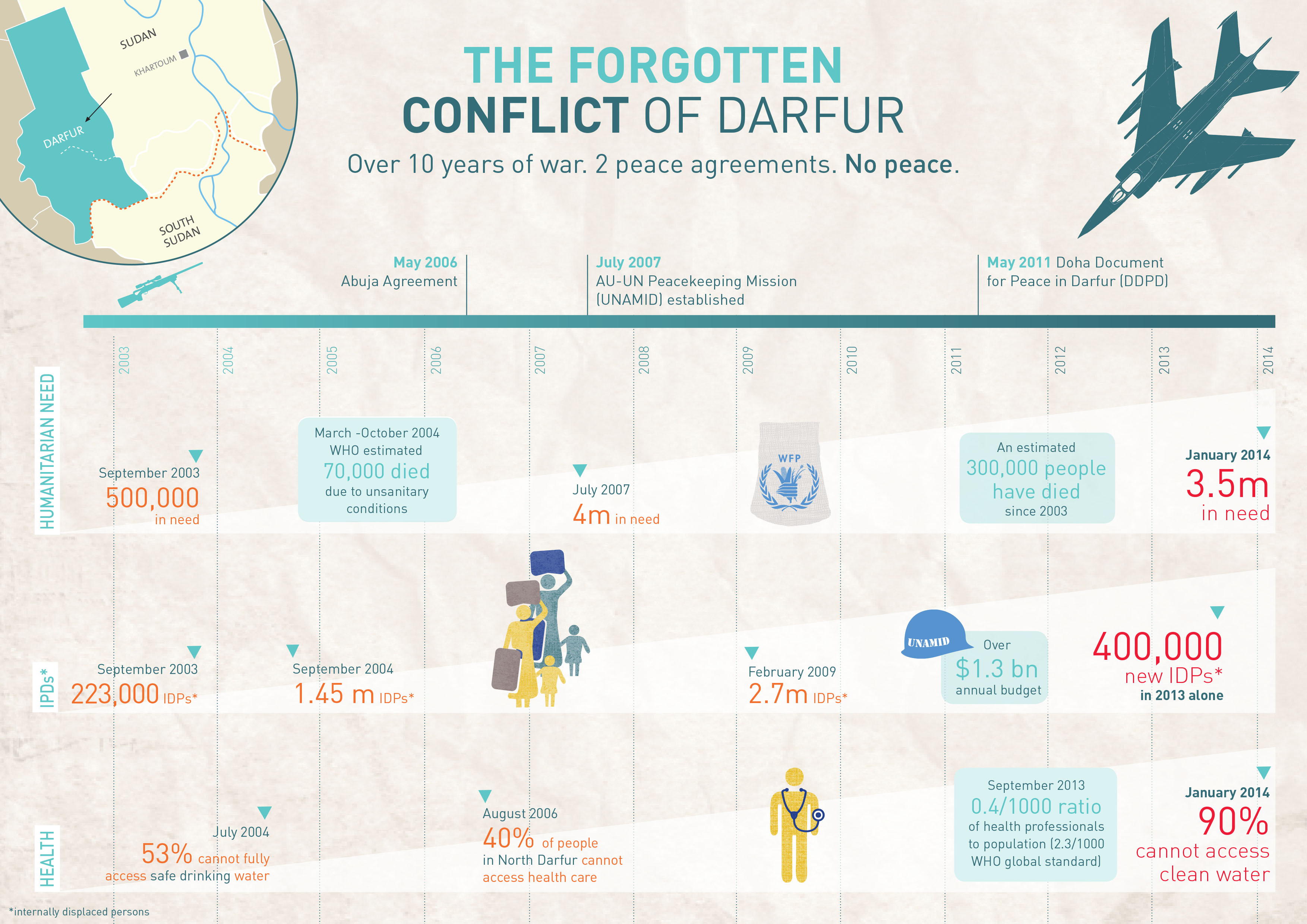Escalating violence, displacement, and new political developments in the areas along Sudan’s periphery—Darfur, South Kordofan, and Blue Nile—are going largely unnoticed as international attention focuses on violence in South Sudan. These two infographics display the negative humanitarian impact of the continued violence and displacement in Darfur, South Kordofan, and Blue Nile. Share the infographics and learn more by reading our report Forgotten Wars: Sudan’s Periphery Smolders with Focus on South Sudan.
Data sources used for infographics:
UNBROKEN CONFLICT in South Kordofan and Blue Nile
Some must travel 65 km for medical attention. Children in BN have no access to education. Enough, Humanitarian Needs Assessment in Sudan’s Blue Nile State, December 2013
77% of mothers give birth without skilled assistance; households in the region are cultivating 73% less land than before the conflict erupted; 65% do not have soap, which reduces diarrhea deaths by up to 50% (WHO); 43% of households don't have enough food to last the week. Enough, Life in the Nuba Mountains. Humanitarian Needs Assessment in Sudan’s South Kordofan State, October 2013. Accessed 8 January 2014
1.2 million people in need in SK and BN. OCHA, Sudan: Humanitarian Snapshot, 31 December 2013
239,000 fled to Ethiopia and South Sudan. OCHA, Sudan: Humanitarian Snapshot (30 November 2013)
Bombardment correlating with planting and harvesting season. Nuba Reports, South Kordofan November – December 2013 Situation Report. Accessed 17 January 2014
Bombing targeting schools, hospitals, markets. The Sudan Consortium, The impact of aerial bombing attacks on civilians in Southern Kordofan, Republic of Sudan, May 2013. Accessed 17 January 2014
Upgraded airplanes double the payload. The Sudan Consortium, African and International Civil Society Action for Sudan, November 2013. Accessed 15 January 2014
More bombings than ever in December 2013, on average 2 attacks per day. The Sudan Consortium, The Impact of Aerial Bombing of Civilian Settlements in Southern Kordofan and Blue Nile States, Republic of Sudan, January 2014. Accessed 17 January 2014
THE FORGOTTEN CONFLICT OF DARFUR
0.4/1000 ratio of health professionals to population (2.3/1000 WHO global standard). OCHA, Humanitarian Dashboard (30 September 2013)
January 2014: 3.5 million people are in need of humanitarian assistance. OCHA, Sudan: Humanitarian Snapshot, 31 December 2013
September 2003: UN agencies estimate at least 500,000 people need humanitarian aid. September 2004: IDPs have swelled to 1.45 million. UN, The UN Responds to the Crisis in Darfur: A Timeline, 2003-2004
Mission currently has just over 19,000 uniformed personnel; 182 UNAMID fatalities; annual budget over $1.3bn. UN, UNAMID African Union/United Nations Hybrid operation in Darfur, November 2013. Accessed 15 January 2014
January 2014: An estimated 300,000 people have died since 2003. 90% cannot access clean water and improved sanitation. UN News Centre, Amid deteriorating conditions in Darfur, UN official urges all parties to join peace effort, January 2014
February 2009: Fighting in Darfur erupted in 2003, causing an estimated 300,000 deaths and forcing some 2.7 million people to flee their homes. UN News Centre, Darfur: UN calls for immediate access to civilians threatened by violent clashes, February 2009
September 2003: 223,000 IDPs in Darfur (Jan-Sept 2003). UN Office for the Coordination of Humanitarian Affairs, Sudan: Humanitarian access to Darfur region agreed, September 2003
August 2006: The WHO has reported that 40% of the population in North Darfur are not receiving health care. UN Office for the Coordination of Humanitarian Affairs, Sudan: Briefing by Jan Egeland, Under-Secretary-General for Humanitarian Affairs and Emergency Relief Coordinator, on the humanitarian situation in Darfur, August 2006
An estimated 400,000 new IDPs in 2013 alone. UNSC, Report of the Secretary-General on the African Union – United Nations Hybrid Operation in Darfur, January 2014
July 2007: Four million people need humanitarian assistance. WHO, Saving the future generation in Darfur, July 2007
October 2004: WHO estimated 70,000 IDPs died in a six month period March – October 2004 because of unsanitary conditions. WHO, Mortality projections for Darfur, Presented by David Nabarro, October 2004
As of end of July 2004, 47% of potential beneficiaries had adequate access to safe drinking water. WHO, Health update for Darfur, Sudan and Chad, August 2004



